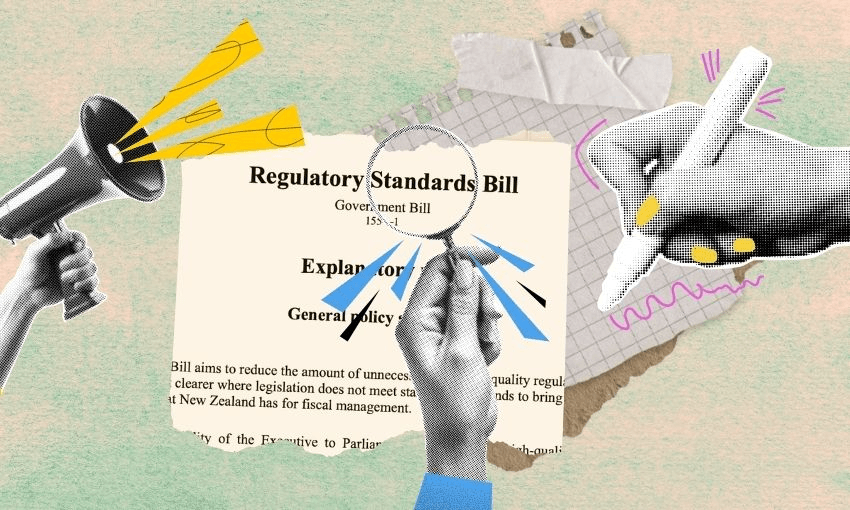Cycling and e-scooting enthusiasts are welcoming legislative upgrades that will improve safety – and match what people are doing already.
It is 2025. You are walking down the street. A child bikes past you on the footpath. You cross the road, waiting a few extra seconds for a bus to slowly pull out from its stop and into traffic. On the other side of the road, an e-scooter rider accelerates in the bike lane.
What is wrong with this picture? Well, the law: technically, it was illegal for the child to be riding on the footpath, and the e-scooter rider to be in the bike lane. Meanwhile, the six cars who didn’t let the bus merge were in the right.
Transport law changes announced by minister Chris Bishop in June will go some way to making the law align with reality. The minister sold it as ways to “take the handbrake off productivity”. The changes include changing WOF frequencies, implementing digital drivers licences and potentially revising regulations for imported vehicles. Of particular interest to some transport advocates are several safety-focused rules: allowing e-scooters to use bike lanes, children to bike on the footpath and requiring cars to give way to merging buses.
“I was always worried that there might be a grumpy pedestrian saying we weren’t allowed on the footpath,” says Philippa Curtis. Living in St Martins in Christchurch, she took her three kids to their primary school on bikes until about two years ago, when they became confident enough to ride on roads.
While they lived only a block away, getting to the primary school on the road required two right turns. “There are bends and corners [on Centaurus Road] and lots of cars at the school run time,” Curtis says. Staying on the footpath was faster and safer, with no road crossings required. “It would be nonsensical to cross the road twice just for a block … safety was a higher priority.” She’s noticed that even now when riding on roads, her youngest child will avoid going into traffic to get around a parked car by going on the footpath.
Cycling on the footpath, where pedestrians will continue to have right of way, requires patience. Curtis’s children had to get used to going slowly, at times, behind people who were walking to school.
The updated rules also have some inconsistencies, as a post on urbanist blog Greater Auckland points out. There’s no clarification on whether parents should be riding next to kids, for instance.
It’s been a long time coming: these changes for bikes and e-scooters were included in the Accessible Streets proposal in February 2020. What Bishop announced took the top line of these changes, without establishing an overall footpath framework to prioritise pedestrians or give cyclists in a bike lane right of way ahead of left-turning traffic.
Jacksen Love, co-founder of rental scooter provider Flamingo, says that allowing e-scooters in cycle lanes was something Flamingo has always wanted. “It just makes sense,” he says. Flamingo operates in seven towns and cities around Aotearoa, including Auckland, Wellington, Dunedin and Tauranga. “When we talk to first time riders, safety comes up as a big barrier,” Love says.
The company has seen a shift away from late-night and weekend use when they first launched, and most users were riding scooters recreationally. Now, the busiest days are during the week. When the rule comes into effect, Flamingo will be able to communicate safe routes in cycle lanes to their users.
Personally, Love is looking forward to Flamingo scooters being officially allowed in the cycle route along Cambridge Terrace in Wellington which goes all the way to Island Bay; at a recent launch for the completed route, they could only use Flamingo’s e-bikes. “It’ll be exciting to eventually have events and promotions to encourage the use of scooters and bikes in bike lanes,” Love says.
The rules for e-scooters and bikes are changing, but have always been hard to enforce. Another rule change would be making a one metre passing distance for cars around bikes in 60km/h and under zones, and 1.5m when the speed limit is above 60. “We strongly support a 1.5m gap and hope it will be enforced quickly,” says Fox Bennetts, a spokesperson for Spokes Canterbury. But without every cyclist and driver carrying around a retractable tape measure, could anyone prove how far away they were when they passed a cyclist?
Cycle advocates would like to see the changes paired with other improvements. E-scooters and e-skateboards in cycle lanes are a reason to fund more cycle lanes, Bennetts says. “The government should fund value for money cycleway infrastructure for the benefit of a wide range of mobility options.”
“While it’s great to update the rules to reflect reality, it’s no excuse to not keep pushing for safer cycleways,” says Curtis. Her kids’ ride to primary school was only a few hundred metres but “we want to go further than that on our bikes, and feel safer to do so”. She says that children should have safe options for riding on roads too, and not have to “re-learn” cycle techniques when they want to go faster than is possible on a footpath.
While people are optimistic about these changes, implementation is still a while away: The changes concerning bikes, e-scooters and buses won’t be in place until 2026. In the meantime, it’s hard to imagine anyone fining a child for riding a bike on the footpath.






